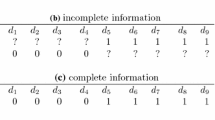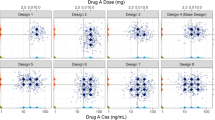Abstract
Combinations of pharmacological treatments are increasingly being investigated for potentially higher clinical benefit, especially when the combined drugs are expected to act via synergistic interactions. The clinical development of combination treatments is particularly challenging, particularly during the dose-selection phase, where a vast range of possible combination doses exists. The purpose of this work was to evaluate the added value of using optimal design for guiding the dose allocation in drug combination dose-finding studies as compared with a typical drug-combination trial. Optimizations were performed using local [D(s)-optimality] and global [ED(s)-optimality] optimal designs to maximize the precision of model parameters in a number of potential exposure-response (E-R) surfaces. A compound criterion [D(s)/V-optimality] was used to optimize the precision of model predictions in specific parts of the E-R surfaces. Optimal designs provided unbiased estimates and significantly improved the accuracy of results relative to the typical design. It was possible to improve the efficiency and overall parameter precision up to 7832% and 96.6% respectively. When the compound criterion was used, the probability to accurately identify the optimal dose-combination increased from 71% for the typical design up to 91%. These results indicate that optimal design methodology in tandem with E-R analyses is a beneficial tool that can be used for appropriate dose allocation in dose-finding studies for drug combinations.





Similar content being viewed by others
References
Srivastava G, Apovian CM. Current pharmacotherapy for obesity. Nat Rev Endocrinol. 2018;14(1):12–24.
Upadhyay J, Polyzos SA, Perakakis N, Thakkar B, Paschou SA, Katsiki N, et al. Pharmacotherapy of type 2 diabetes: an update. Metabolism. 2018;78:13–42.
Lopez JS, Banerji U. Combine and conquer: challenges for targeted therapy combinations in early phase trials. Nat Rev Clin Oncol. 2017;14(1):57–66.
Zimmermann GR, Lehár J, Keith CT. Multi-target therapeutics: when the whole is greater than the sum of the parts. Drug Discov Today. 2007;12(1–2):34–42.
Greco WR, Bravo G, Parsons JC. The search for synergy: a critical review from a response surface perspective. Pharmacol Rev. 1995;47(2):331–85.
Papathanasiou T, Strathe A, Hooker AC, Lund TM, Overgaard RV. Feasibility of exposure-response analyses for clinical dose-ranging studies of drug combinations. AAPS J. 2018;20(3):64.
Nøhr-Nielsen A, De Bruin ML, Thomsen M, Pipper CB, Lange T, Bjerrum OJ, et al. Body of evidence and approaches applied in the clinical development program of fixed-dose combinations in the European Union from 2010-2016. Br J Clin Pharmacol. 2019;85(8):1829–40.
Kimko H, Pinheiro J. Model-based clinical drug development in the past, present and future: a commentary. Br J Clin Pharmacol. 2015;79(1):108–16.
Musuamba FT, Manolis E, Holford N, Cheung S, Friberg LE, Ogungbenro K, et al. Advanced methods for dose and regimen finding during drug development: summary of the EMA/EFPIA workshop on dose finding (London 4-5 December 2014). CPT Pharmacometrics Syst Pharmacol. 2017;6(7):418–29.
Overgaard RV, Ingwersen SH, Tornøe CW. Establishing good practices for exposure-response analysis of clinical endpoints in drug development. CPT Pharmacometrics Syst Pharmacol. 2015;4(10):565–75.
Papathanasiou T, Juul RV, Gabel-Jensen C, Kreilgaard M, Heegaard AM, Lund TM. Quantification of the pharmacodynamic interaction of morphine and gabapentin using a response surface approach. AAPS J. 2017;19(6):1804–13.
Retout S, Duffull S, Mentré F. Development and implementation of the population fisher information matrix for the evaluation of population pharmacokinetic designs. Comput Methods Prog Biomed. 2001;65(2):141–51.
Nyberg J, Karlsson MO, Hooker AC. Simultaneous optimal experimental design on dose and sample times. J Pharmacokinet Pharmacodyn. 2009;36(2):125–45.
Nyberg J, Ueckert S, Strömberg EA, Hennig S, Karlsson MO, Hooker AC. PopED: an extended, parallelized, nonlinear mixed effects models optimal design tool. Comput Methods Prog Biomed. 2012;108(2):789–805.
Miller F, Guilbaud O, Dette H. Optimal designs for estimating the interesting part of a dose-effect curve. J Biopharm Stat. 2007;17(6):1097–115.
Atkinson AD, Alexander Tobias, Randall. Optimum experimental designs, with SAS: Oxford University Press; 2007
Dodds MG, Hooker AC, Vicini P. Robust population pharmacokinetic experiment design. J Pharmacokinet Pharmacodyn. 2005;32(1):33–64.
Papathanasiou T, Juul RV, Heegaard AM, Kreilgaard M, Lund TM. Co-administration of morphine and gabapentin leads to dose dependent synergistic effects in a rat model of postoperative pain. Eur J Pharm Sci. 2016;82:97–105.
Keizer RJ, Karlsson MO, Hooker A. Modeling and simulation workbench for NONMEM: tutorial on Pirana, PsN, and Xpose. CPT Pharmacometrics Syst Pharmacol. 2013;2:e50.
Beal S, Sheiner L, Boeckmann A, Bauer R. NONMEM user’s guides. (1989–2009). Ellicott: Icon Dev Solut; 2009.
Kümmel A, Bonate PL, Dingemanse J, Krause A. Confidence and prediction intervals for pharmacometric models. CPT Pharmacometrics Syst Pharmacol. 2018;7(6):360–73.
Kågedal M, Karlsson MO, Hooker AC. Improved precision of exposure-response relationships by optimal dose-selection. Examples from studies of receptor occupancy using PET and dose finding for neuropathic pain treatment. J Pharmacokinet Pharmacodyn. 2015;42(3):211–24.
Myers RH, Montgomery DC, Anderson-Cook CM. Response surface methodology: process and product optimization using designed experiments. 4th Edition ed: Wiley; 2016.
Bretz F, Dette H, Pinheiro JC. Practical considerations for optimal designs in clinical dose finding studies. Stat Med. 2010;29(7–8):731–42.
Wicha SG, Chen C, Clewe O, Simonsson USH. A general pharmacodynamic interaction model identifies perpetrators and victims in drug interactions. Nat Commun. 2017;8(1):2129.
Minto CF, Schnider TW, Short TG, Gregg KM, Gentilini A, Shafer SL. Response surface model for anesthetic drug interactions. Anesthesiology. 2000;92(6):1603–16.
Twarog NR, Stewart E, Hammill CV, Shelat AA. BRAID: a unifying paradigm for the analysis of combined drug action. Sci Rep. 2016;6:25523.
Pierrillas PB, Fouliard S, Chenel M, Hooker AC, Friberg LF, Karlsson MO. Model-based adaptive optimal design (MBAOD) improves combination dose finding designs: an example in oncology. AAPS J. 2018;20(2):39.
Aoki Y, Röshammar D, Hamrén B, Hooker AC. Model selection and averaging of nonlinear mixed-effect models for robust phase III dose selection. J Pharmacokinet Pharmacodyn. 2017;44(6):581–97.
Funding
This work was financially supported by the Novo Nordisk STAR Fellowship Programme and the Innovation Fund Denmark.
Author information
Authors and Affiliations
Corresponding author
Additional information
Publisher’s Note
Springer Nature remains neutral with regard to jurisdictional claims in published maps and institutional affiliations.
Rights and permissions
About this article
Cite this article
Papathanasiou, T., Strathe, A., Overgaard, R.V. et al. Optimizing Dose-Finding Studies for Drug Combinations Based on Exposure-Response Models. AAPS J 21, 95 (2019). https://doi.org/10.1208/s12248-019-0365-3
Received:
Accepted:
Published:
DOI: https://doi.org/10.1208/s12248-019-0365-3




